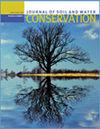在流域模型中模拟行为异质性:SWAT研究中肥料使用的系统综述
IF 2.6
4区 农林科学
Q2 ECOLOGY
引用次数: 3
摘要
非点源污染是美国水质下降的主要原因。这种污染主要是由农田施肥和粪肥造成的。最广泛用于预测氮肥和磷肥施用对养分负荷影响的水文模型之一是水土评估工具(SWAT)。虽然SWAT在改善生物物理过程的表现方面取得了重要进展,但建模者往往无法捕捉到人类土地管理行为的复杂性。同时,几十年的社会科学研究表明,农民不是一个同质的群体,而是表现出复杂多样的行为。在本文中,我们对最近发表的论文进行了系统的回顾,这些论文使用SWAT来记录建模社区如何典型地表示肥料施用行为。我们将这些表示与最近农民调查的结果进行比较,这些调查获得了有关化肥施用量的信息。我们发现,大多数SWAT模型应用程序假设农民田间管理行为是相对同质的(例如,所有农民的行为方式都相同),并且农民通常使用合理的农艺或经济标准施用肥料。这些简化的假设与农民施肥行为的现实相冲突。明尼苏达州和俄亥俄州的农民调查显示,玉米(Zea mays L.)田的氮磷肥施用量在大豆(Glycine max [L.])田之后存在相当大的差异。)稳定)。SWAT模型方法与农民调查结果之间的脱节,为更好地体现SWAT和其他水文模型中农民施肥行为的异质性提供了机会,这可以提高我们将土地利用和管理变化与水质联系起来的能力,并提高保护计划干预措施的有效性。本文章由计算机程序翻译,如有差异,请以英文原文为准。
Simulating behavioral heterogeneity in watershed models: A systematic review of fertilizer use in SWAT studies
Nonpoint source pollution is the primary cause of reduced water quality in the United States. This pollution results primarily from fertilizer and manure application in farmland. One of the hydrological models most widely used to predict the effect of nitrogen (N) and phosphorus (P) fertilizer application on nutrient loadings is the Soil and Water Assessment Tool (SWAT). While important advances have been made to improve the representation of biophysical processes within SWAT, modelers often fail to capture the complexity of human land management behaviors. Meanwhile, decades of social science research have demonstrated that farmers are not a homogeneous group, but rather exhibit complex and diverse behaviors. In this paper we present a systematic review of recently published papers that use SWAT to document how the modeling community typically represents fertilizer application behaviors. We compare these representations with findings from recent farmer surveys that captured information about fertilizer application rates. We found that most SWAT model applications assume that farmer field management behaviors are relatively homogeneous (e.g., all farmers behave in the same way), and that farmers generally apply fertilizer using rational agronomic or economic criteria. These simplifying assumptions conflict with the reality of farmers’ fertilizer behavior. Farmer surveys in Minnesota and Ohio show considerable variability in N and P fertilizer application rates on corn (Zea mays L.) fields following soybeans (Glycine max [L.] Merr.). The disconnect between SWAT modeling approaches and results of farmer surveys point to opportunities to better represent the heterogeneity of farmers’ fertilizer behavior in SWAT and other hydrologic models, which could improve our ability to link changes in land use and management to water quality and increase the effectiveness of conservation program interventions.
求助全文
通过发布文献求助,成功后即可免费获取论文全文。
去求助
来源期刊
CiteScore
4.10
自引率
2.60%
发文量
0
审稿时长
3.3 months
期刊介绍:
The Journal of Soil and Water Conservation (JSWC) is a multidisciplinary journal of natural resource conservation research, practice, policy, and perspectives. The journal has two sections: the A Section containing various departments and features, and the Research Section containing peer-reviewed research papers.

 求助内容:
求助内容: 应助结果提醒方式:
应助结果提醒方式:


